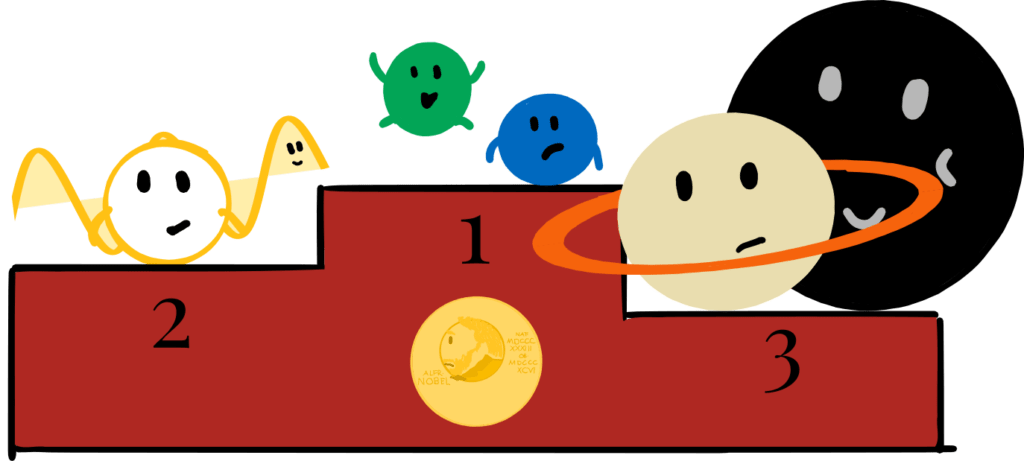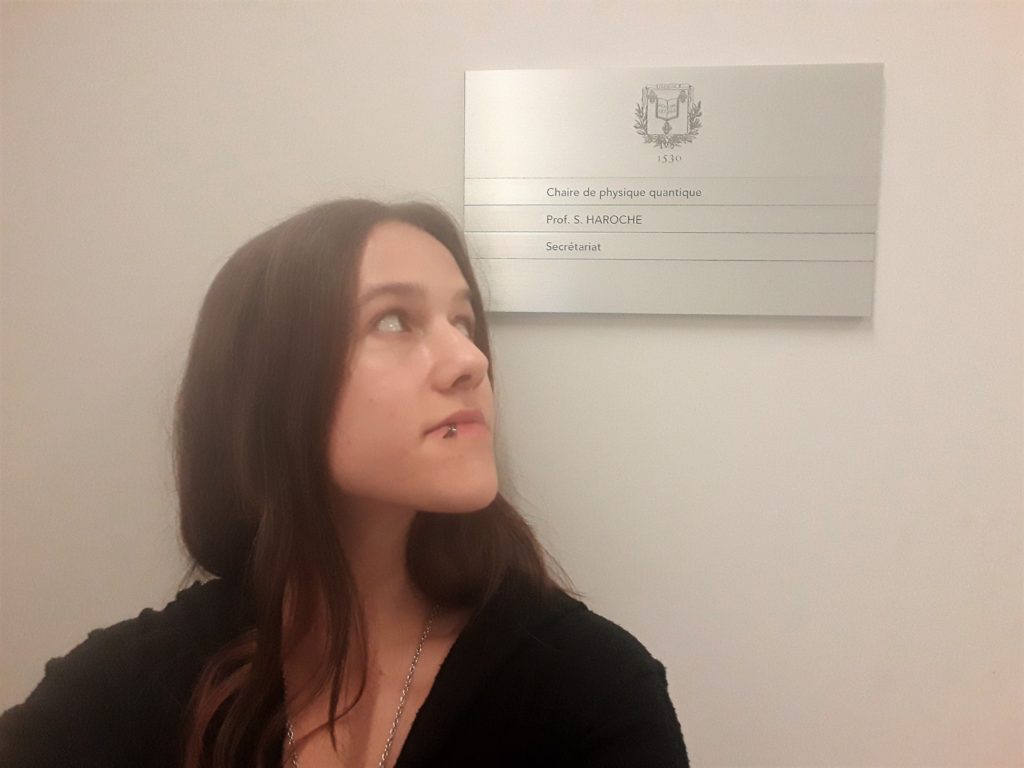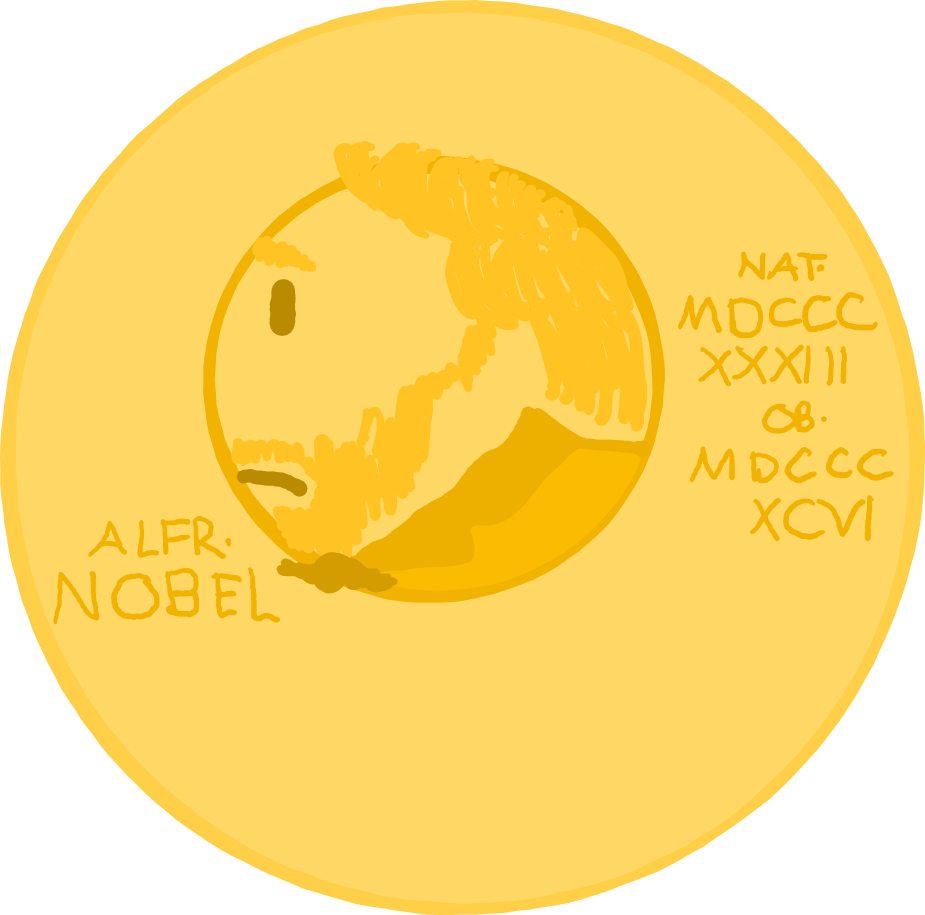Nobel Prize week is over. The one week of the year when scientists are stars of the media and everyone seems to be interested in research. If scientists were celebrated every day like musicians or movie stars and printed on posters in teen magazines – our world would certainly look very different. But until that happens, we’ll have to make do with this one week of fame.
Nobel’s noble idea
The Nobel Prize was named after the Swedish inventor and chemist Alfred Bernhard Nobel. In addition to the Nobel Prize, an element, Nobelium, and a laurel plant, Nobeliodendron, also bear his name. Nobel was not married and had no children, and when he died in 1896, the man of science bequeathed 94% of his 31 million crown fortune to science. He decreed that henceforth annual awards would be made for the greatest achievements in physics, chemistry, medicine, literature, and for the benefit of peace. The Nobel Foundation invested the fortune in various places, and today it amounts to almost 3 billion crowns (290 million euros). About 120 million crowns (11.5 million euros) are spent annually on the Nobel Prize awards: The prize money for each category is 10 million kroner (962,000 euros), 20 million kroner goes to the Nobel Prize party, and the rest is spent on administration, symposia, organization and the like.
A noble thought. But one rarely accumulates so much wealth through charitable work. Nobel patented 355 inventions during his lifetime – one of them being dynamite. During his experiments, there were quite a few accidents, including the death of his brother Emil. About a decade before Nobel’s death, a mix-up occurred: when his brother Ludvig died, a French newspaper mistakenly wrote an obituary for Alfred Nobel. It was entitled “Le marchand de la mort est mort” (“The merchant of death is dead”). Nobel was horrified by the image the public had of him. The Nobel Prize may have been a way for Nobel to appease his guilty conscience.
Spurned hearts and disgraceful research
Many wonder why there is no Nobel Prize for mathematics. There are several theories here. The most likely is that the practical-minded Nobel considered mathematics an “auxiliary science” and thus unimportant. According to another theory, one of Nobel’s mistresses broke his heart when she rejected him in favor of a mathematician. Mathematics itself, however, does not grieve over this, but has its own Nobel Prize: the Fields Medal, though less highly endowed, is just as highly regarded among mathematicians.
In addition to the Fields Medal, the Nobel Prize has inspired another prize: the Ig-Nobel Prize. The name is a pun on Nobel’s name and the English word ignoble, which means unworthy. Contrary to this name, however, the Ig-Nobel Prize is not a medal of shame like, say, the Golden Raspberry in Hollywood. Awards are given for useless, whimsical or entertaining research achievements in ten different categories, but not for the same ones every year.
For example, the Ig Nobel Prize was awarded for studying whether cats are both solids and liquids (Physics 2017), for disproving the 5-second rule for dropped food (Public Health 2004), and for proving that chimpanzees in zoos are as likely to imitate humans as vice versa (Anthropology 2018). If you are in a bad mood, I recommend reading the Ig-Nobel Prize list, it is terrific. By the way, there is a person, Andre Geim, who won both the Nobel Prize (in physics for research on graphene) and the Ig-Nobel Prize (also in physics, for his experiment to make a frog levitate using a magnet). That the Ig-Nobel Prize is also satire is shown by this year’s Medical Teaching Prize. It went to nine politicians, including Donald Trump, “for using the COVID-19 pandemic to show the world that politicians can have a more immediate impact on life and death than scientists and doctors.”
Lone wolves
Let’s move on from this year’s Ig-Nobel Prize to the Nobel Prize. This year’s Nobel Prize in Physics went to three scientists for research on black holes. I am happy to say that one of them was a woman. Thus, there are four female physics Nobel laureates: Andrea Ghez (2020), Donna Strickland (2018), Maria Goeppert-Mayer (1963) and Marie Curie (1903). The Nobel Prize in Physics has been awarded 114 times since 1901 to a total of 215 people. This brings us to 1.9% and the lowest percentage of women of all five Nobel Prize categories.
Many think this is no mere coincidence and is not solely due to the low proportion of women in physics. The Nobel Prize earns criticism that it is “surprisingly” often awarded to white men. In 1903, only Pierre Curie, together with Antoine Henri Becquerel, was supposed to be awarded for the discovery of radioactivity. It was only at Pierre’s insistence that his wife had as large a part in the research as he did that the prize was awarded half to Becquerel, and a quarter each to Pierre and Marie Curie.
In 2018, there was much debate about Donna Strickland and her Nobel Prize. It was awarded for the development of new methods in the field of laser physics, half to Arthur Ashkin and a quarter each to Donna Strickland and her doctoral advisor Gérard Mourou. This is the crux of the matter: the two developed the method in question 30 years ago, when Strickland was still a doctoral student of Mourou. Doctoral students work hard and do a lot of research, but in most cases, the “idea generators” are their supervisors. Some wicked tongues ask whether Strickland really deserved the Nobel Prize for that bit of button-pushing. Even in the Nobel Prize portrait of a physics magazine, Mourou was singled out and Strickland was mentioned only in passing. Until the award, Strickland did not even have a Wikipedia entry.
Teamwork
Here another problem of the Nobel Prize arises: only a maximum of three persons can be awarded. At the beginning of the 20th century, this may still have been appropriate. Luminaries such as Wilhelm Röntgen (who received the very first Nobel Prize), Max Planck, Albert Einstein, or Niels Bohr carried out their research almost single-handedly (although even that is doubtful in many cases). Scrolling through the list of early Nobel Prizes, one often reads the phrase “for the effect named after him” (see X-rays, Planck’s radiation law, Einstein’s coefficients, Bohr’s atomic model). But nowadays, research works differently. Research is a team effort and cannot be attributed to three people – let alone one individual.
The best examples are the 2017 gravitational wave detection and the 2013 discovery of the Higgs boson. LIGO and CERN, the research facilities where these two discoveries were made, employ hundreds or even thousands of scientists. One of the publications on the discovery of the Higgs boson broke a new record with 5154 authors – the eight pages of research were followed by 24 pages of author listings. One of the authors had already died by the time of publication. An unlikely event that is no longer surprising based on statistics and the number of authors alone. The question is: Who of these 5154 researchers deserves the Nobel Prize?
Also this year, the Nobel Prize was awarded to the maximally allowed three researchers. It went to Roger Penrose, Reinhard Genzel and Andrea Ghez. As in the case of Donna Strickland, the female researcher received a quarter of the prize. Genzel and Ghez share one-half of the prize for the discovery of the black hole at the center of our Milky Way. Roger Penrose is the mathematician and theoretical physicist of the lot. He explored the implications of Einstein’s general theory of relativity and proved that black holes can exist. That was 55 years ago. The idea of the Nobel Prize was to recognize the greatest achievements of the past year – a concept that is not and cannot be applied. It often takes decades to determine whether a discovery was groundbreaking or simply correct. It’s interesting that some rules are set in stone and others are casually thrown overboard.
Bronze, silver, gold
With black holes, last year’s exoplanets, and 2017’s gravitational waves, it seems that astrophysics very much dominates the Nobel Prize. Much to my chagrin as a quantum physicist. I was curious and did the count: The overwhelming winner is particle physics, with 41 awards since the inception of the Nobel Prize. This includes Higgs’ famous “God particle”. It is followed by quantum physics with 18 prizes and astrophysics with 15. These numbers are approximations because it is sometimes hard to tell which category a prize falls into. Unfortunately, the trend is not very good for quantum physics. It had its prime between 1918, when Max Planck received the Nobel Prize for the discovery of quanta, and the 1960s, with Richard Feynman and the development of quantum electrodynamics. Astrophysics, on the other hand, didn’t make its entrance until 1936 with the discovery of cosmic rays, but made decent gains in the last two decades.

Wineland and Haroche
The last Nobel Prize for quantum physics – while we wait for the long-awaited breakthrough in quantum technology – went to David Wineland and Serge Haroche in 2012 for their experiments on taming quantum systems. I explained this idea earlier in my article on Quantum Technology 2.0, and indeed Wineland and Haroche’s work forms the foundation for many areas of quantum technology. Wineland developed methods to trap and control ions. Haroche uses atoms to trap and manipulate single photons and even observe their creation. He comes from the Collège de France and the Ecole Normale Supérieure (ENS) in Paris. The ENS is an elite institution that admits fewer than 250 students per year. Thanks to this selective choice, it has 1.35 Nobel laureates per 1,000 students, putting it ahead of Caltech and Harvard.
This particular Nobel Prize has special meaning for me because I have been fortunate to work with Serge Haroche’s group for more than four years. In fact, at this very moment, I am in Paris and day in and day out in the laboratory where Serge Haroche conducted his groundbreaking experiments. Just yesterday, Haroche himself shuffled past my office. Don’t get me wrong – I’m a theoretician, and the only practical things I’ve done in that lab were change a light bulb, hook up a computer monitor, and sort a thousand tiny screws by hand into a box by size after the lab’s PhD student threw that very box of a thousand tiny screws on the floor on the first day of his PhD. I assure you, something like that welds together. After two hours of sorting screws and three years of doing our doctorate together, we are still friends today.

My first seminar in my bachelor studies was about an experiment by Serge Haroche. For my bachelor thesis, I developed a theoretical description for another of his experiments. My master’s thesis, my first scientific publication, and most of my doctoral thesis were written in close collaboration with this group. I bought Serge Haroche’s book and never dared to ask him for his autograph until today. In my apartment, the Nobel Prize poster of Haroche and Wineland hangs on the wall. It was these experiments that took me from my bachelor’s degree to my doctorate and regularly fueled my fascination with quantum physics. I hope that more Nobel Prizes will do the same for future generations of scientists and that they won’t have to send emails to Sweden to get posters of their role models. In 2008, the German teen magazine “Bravo” published a poster of Barack Obama. When is the poster of Andrea Ghez coming?
Do you like what you read? Then you can buy me a coffee here! And if you don’t want to miss any new post don’t forget to subscribe to my blog

